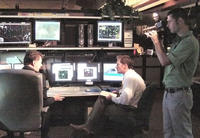-
New material for sustainable road building: "poticrete"
An organization dedicated to promoting sustainable roadway construction, awarded its first official certification to a Bellingham, Washington, project that incorporates porcelain from recycled toilets; a newly widened sidewalk in Bellingham incorporates more than 400 recycled toilets, crushed into what the project engineers have dubbed “poticrete”
-
-
NYC cyberattack simulation to spur Senate cybersecurity legislation

Last Wednesday, in an attempt to bolster support for cybersecurity legislation, the White House staged a mock cyberattack on New York City’s power supply for the Senate
-
-
Fukushima lesson: be ready for unanticipated nuclear accidents
A year after the Fukushima disaster all but two of Japan’s fifty-four nuclear reactors remain shut down, in a country where nuclear power once supplied nearly 30 percent of the electricity; the Japanese government is awarding an initial $13 billion in contracts to begin decontamination and rehabilitation of the more than 8,000-square-mile region most exposed to radioactive fallout
-
-
The future of nuclear energy
While the lessons of the 11 March 2011 Fukushima disaster are being absorbed, the United States is moving forward with nuclear power; for the first time since 1978, the U.S. National Regulatory Commission has approved two new plants; the $14 billion facilities will be built just outside Augusta, Georgia
-
-
National Academies calls for expanded nuclear-fusion research
A report out on Wednesday from the National Academies says university researchers studying nuclear fusion still have a long way to go before overcoming the many scientific hurdles to the commercial generation of what is hoped to be a virtually limitless supply of energy
-
-
Better policies needed to reduce radiation exposure in nuclear accidents
A new study says that offsite policies and plans should be put in place to reduce the exposure of the public to radiation in the event of a nuclear power plant accident
-
-
Shift to green energy could mean crunch in rare Earth metals supply
A large-scale shift from coal-fired electric power plants and gasoline-fueled cars to wind turbines and electric vehicles could increase demand for two already-scarce metals — available almost exclusively in China — by 600-2,600 percent over the next twenty-five years
-
-
New material to improve efficiency of power grids
Global energy demand is on the rise, as populations continue to grow and industrialization progresses; at the same time, there is a growing awareness and concern about repercussions of increasing rates of carbon dioxide emissions released in the atmosphere; a new nanocomposite material holds the promise of enabling smarter, more reliable, and greener power systems
-
-
Infrastructure security, disaster planning “Super map” developed

A U.S. Marine stationed at the Quantico base in Virginia has developed sophisticated mapping software that can give users full situational awareness of their surroundings in real-time; the software is a “super map” taking in a torrent of data streams from emergency dispatch reports to weather forecasts, traffic reports, and security system alerts
-
-
If Japan-like disaster happened in U.S., results would be far worse
An estimated 20,000 people died or are still missing after a massive earthquake-induced tsunami struck Japan on 11 March 2011, yet some 200,000 people were in the inundation zone at the time; experts say that if the same magnitude earthquake and tsunami hits the Pacific Northwest, the death toll will be much higher because of the lack of comparable preparation; that 90 percent rate could be the number of victims, not survivors
-
-
Industry: current chemical safety standards sufficient, should be extended
DHS’s management of the U.S. chemical plant safety has come under criticism lately, but he Society of Chemical Manufactures and Affiliates (SOCMA) said it strongly supports U.S. chemical security standards; the industry associated noted that since the program’s 2007 launch, more than 2,000 facilities have changed processes or inventories such that they are no longer considered high-risk under the Chemical Facility Anti-Terrorism Standards (CFATS)
-
-
Critics: current chemical safety standards insufficient, should not be extended
Critics of the current chemical plant safety standards say these standard are insufficient and should be extended; critics cite EPA data to highlight the fact that current safety standards leave more than 110 million Americans at risk from high-risk chemical plants
-
-
Top LulzSec hackers arrested, leader turns them in
In the ongoing battle between law enforcement officials and hackers, authorities announced on Tuesday that they had arrested leading members of the hacktivist group known as LulzSec after their leader allegedly turned them in
-
-
Solving the major problem of renewable energy: intermittency
Intermittency, sometimes called the Achilles’ heel of renewable energy, has so far limited the penetration of renewable sources in most power grids; engineers imagine an energy future where giant transmission grids are backed up by massive energy storage units
-
-
National Weather Service budget cuts threaten poor IT infrastructure

The Obama administration has proposed cutting more than $39 million from the National Weather Service’s (NWS) budget, particularly from its IT department, and critics worry that the cuts could cause the agency’s already crippling infrastructure problems to grow worse
-
More headlines
The long view
Falling Space Debris: How High Is the Risk I'll Get Hit?
An International Space Station battery fell back to Earth and, luckily, splashed down harmlessly in the Atlantic. Should we have worried? Space debris reenters our atmosphere every week.
Using Drone Swarms to Fight Forest Fires
Forest fires are becoming increasingly catastrophic across the world, accelerated by climate change. Researchers are using multiple swarms of drones to tackle natural disasters like forest fires.
Strengthening the Grid’s ‘Backbone’ with Hydropower
Argonne-led studies investigate how hydropower could help add more clean energy to the grid, how it generates value as grids add more renewable energy, and how liner technology can improve hydropower efficiency.
LNG Exports Have Had No Impact on Domestic Energy Costs: Analysis
U.S. liquified natural gas (LNG) exports have not had any sustained and significant direct impact on U.S. natural gas prices and have, in fact, spurred production and productivity gains, which contribute to downward pressure on domestic prices.
